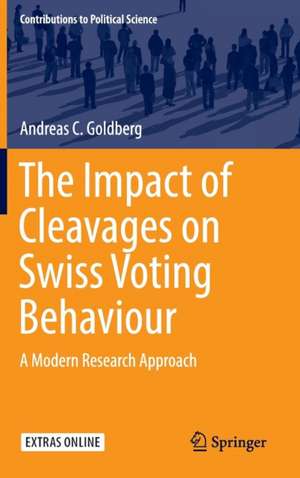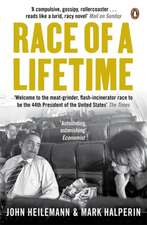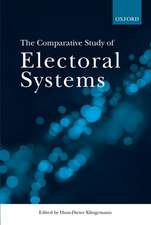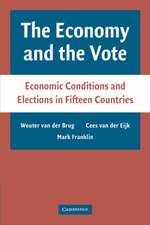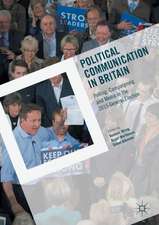The Impact of Cleavages on Swiss Voting Behaviour: A Modern Research Approach: Contributions to Political Science
Autor Andreas C. Goldbergen Limba Engleză Hardback – 15 dec 2016
This book studies the impact of cleavages on electoral choices. Based on a case study of Switzerland, it analyses how cleavages divide voters into voting blocs and how this influences Swiss voting behaviour and the Swiss party system. The first part examines the development of salient cleavages such as religion, social class, rural-urban, and language between 1971 and 2011. Behavioural changes among voters and changes in the size of social groups are explored as explanatory factors for the decline of cleavage voting. The second part proposes a contextual perspective analysis of the current impact of cleavages using both individual and contextual factors. These factors are also combined to examine interaction effects between the individual and the context. Finally, the third part analyses whether the impact of cleavages has harmonised across different contexts (Swiss cantons) over time.
| Toate formatele și edițiile | Preț | Express |
|---|---|---|
| Paperback (1) | 386.00 lei 43-57 zile | |
| Springer International Publishing – 29 apr 2018 | 386.00 lei 43-57 zile | |
| Hardback (1) | 393.35 lei 43-57 zile | |
| Springer International Publishing – 15 dec 2016 | 393.35 lei 43-57 zile |
Din seria Contributions to Political Science
- 18%
 Preț: 724.17 lei
Preț: 724.17 lei - 24%
 Preț: 633.40 lei
Preț: 633.40 lei - 17%
 Preț: 524.55 lei
Preț: 524.55 lei - 15%
 Preț: 583.61 lei
Preț: 583.61 lei -
 Preț: 380.63 lei
Preț: 380.63 lei - 15%
 Preț: 471.69 lei
Preț: 471.69 lei - 18%
 Preț: 780.82 lei
Preț: 780.82 lei - 18%
 Preț: 785.86 lei
Preț: 785.86 lei -
 Preț: 379.86 lei
Preț: 379.86 lei - 15%
 Preț: 695.85 lei
Preț: 695.85 lei -
 Preț: 390.84 lei
Preț: 390.84 lei - 18%
 Preț: 777.50 lei
Preț: 777.50 lei -
 Preț: 387.75 lei
Preț: 387.75 lei - 18%
 Preț: 791.71 lei
Preț: 791.71 lei -
 Preț: 394.29 lei
Preț: 394.29 lei - 15%
 Preț: 635.15 lei
Preț: 635.15 lei -
 Preț: 381.42 lei
Preț: 381.42 lei - 18%
 Preț: 798.66 lei
Preț: 798.66 lei -
 Preț: 392.37 lei
Preț: 392.37 lei -
 Preț: 391.02 lei
Preț: 391.02 lei -
 Preț: 359.76 lei
Preț: 359.76 lei - 18%
 Preț: 788.90 lei
Preț: 788.90 lei -
 Preț: 387.58 lei
Preț: 387.58 lei -
 Preț: 395.47 lei
Preț: 395.47 lei - 20%
 Preț: 579.41 lei
Preț: 579.41 lei - 15%
 Preț: 643.34 lei
Preț: 643.34 lei -
 Preț: 384.86 lei
Preț: 384.86 lei -
 Preț: 487.57 lei
Preț: 487.57 lei - 18%
 Preț: 781.62 lei
Preț: 781.62 lei - 18%
 Preț: 734.09 lei
Preț: 734.09 lei - 15%
 Preț: 645.79 lei
Preț: 645.79 lei - 15%
 Preț: 698.62 lei
Preț: 698.62 lei -
 Preț: 396.62 lei
Preț: 396.62 lei - 15%
 Preț: 584.26 lei
Preț: 584.26 lei - 18%
 Preț: 727.80 lei
Preț: 727.80 lei - 15%
 Preț: 651.84 lei
Preț: 651.84 lei
Preț: 393.35 lei
Nou
Puncte Express: 590
Preț estimativ în valută:
75.29€ • 81.81$ • 63.29£
75.29€ • 81.81$ • 63.29£
Carte tipărită la comandă
Livrare economică 21 aprilie-05 mai
Preluare comenzi: 021 569.72.76
Specificații
ISBN-13: 9783319459998
ISBN-10: 3319459996
Pagini: 336
Ilustrații: XII, 244 p. 75 illus.
Dimensiuni: 155 x 235 x 16 mm
Greutate: 0.54 kg
Ediția:1st ed. 2017
Editura: Springer International Publishing
Colecția Springer
Seria Contributions to Political Science
Locul publicării:Cham, Switzerland
ISBN-10: 3319459996
Pagini: 336
Ilustrații: XII, 244 p. 75 illus.
Dimensiuni: 155 x 235 x 16 mm
Greutate: 0.54 kg
Ediția:1st ed. 2017
Editura: Springer International Publishing
Colecția Springer
Seria Contributions to Political Science
Locul publicării:Cham, Switzerland
Cuprins
Introduction.- Theory of Cleavage Voting.- Longitudinal Impact of Cleavages.- Impact Across Parties.- Contextual Approach of Voting.- Combined Approach in a Longitudinal and Contextual Perspective.- General Conclusion.- Appendix.- Online Appendix.
Notă biografică
Andreas Goldberg is a post-doctoral researcher at the Amsterdam School of Communication Research (ASCoR), University of Amsterdam. Prior to that, he has worked as researcher at the University of Geneva, where he has received his PhD in political science in 2015. During his PhD he has also worked for the Swiss Electoral Studies Project at FORS, the Swiss Centre of Expertise in the Social Sciences in Lausanne. His research interests include voting behaviour, participation and survey methods.
Textul de pe ultima copertă
This book studies the impact of cleavages on electoral choices. Based on a case study of Switzerland, it analyses how cleavages divide voters into voting blocs and how this influences Swiss voting behaviour and the Swiss party system. The first part examines the development of salient cleavages such as religion, social class, rural-urban, and language between 1971 and 2011. Behavioural changes among voters and changes in the size of social groups are explored as explanatory factors for the decline of cleavage voting. The second part proposes a contextual perspective analysis of the current impact of cleavages using both individual and contextual factors. These factors are also combined to examine interaction effects between the individual and the context. Finally, the third part analyses whether the impact of cleavages has harmonised across different contexts (Swiss cantons) over time.
Caracteristici
Studies the impact of cleavages on Swiss voting behavior Analyzes how cleavages divide voters into voting blocs Examines the development of salient cleavages such as religion, social class, the rural-urban division, and language
